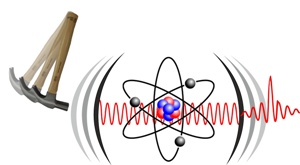Sep 27 2013
Usually, an elementary light source – such as an excited atom or molecule – emits light at an unpredictable instance in time. This spontaneous emission of light is a fundamental process within applications such as LEDs and lasers. However, for other applications it is desirable to receive single photons (light) at a specific moment with as little uncertainty as possible.
For instance, this property is crucial for ultra-secure communication using quantum cryptography. Therefore, an important research goal is to fabricate a quantum light source that emits a single photon exactly at a desired moment in time.
 The superfast emission of a light source. The light source is embedded in an optical resonator where it spontaneously emits a photon. During the emission of the photon the favoured colour of the resonator is quickly switched (symbolised by a hammer) to match the colour of the light source. During this short interval the light source is triggered to emit an burst of photons within a desired moment in time.
The superfast emission of a light source. The light source is embedded in an optical resonator where it spontaneously emits a photon. During the emission of the photon the favoured colour of the resonator is quickly switched (symbolised by a hammer) to match the colour of the light source. During this short interval the light source is triggered to emit an burst of photons within a desired moment in time.
Switching light emission
The average emission time of quantum light sources can be reduced by locating them in various nanostructures, such as optical resonators or waveguides. The smallest uncertainty in the emission time is then limited by the type of nanostructure used and the variations in the preparation time of the emitter.
The Dutch-French team proposes to overcome these limitations by quickly switching the resonator length in which the light source is located. The time duration of the switch should be much shorter than the average emission time. The result is that the favoured light colour of the resonator only matches the emission colour of the light source within a short time interval. Only within this time frame the photons are emitted by the light source into the resonator.
Ultrafast light source
The researchers propose to use quantum dot light sources for this design. Quantum dots can easily be integrated in resonators with lengths of the order of microns. The resonator will be switched by shining an ultrashort laser pulse at it during the emission time of the quantum dots. The laser pulse quickly changes the refractive index in the resonator, and thereby changes the effective resonator length. The switching time can be directly controlled by the arrival time of the short laser pulse and the lifetime of the excited electrons.
These controlled light switches have applications in creating light sources for fast stroboscopes without laser speckle, quantum cryptography, and studying ultrafast cavity quantum electrodynamics.
The team
The research has been performed by FOM postdoc Dr. Henri Thyrrestrup, Dr. Alex Hartsuiker and FOM workgroup leader Prof.dr. Willem L. Vos from the Complex Photonic Systems (COPS) Chair at the MESA+ Institute for Nanotechnology of the University of Twente in Enschede, The Netherlands, in close collaboration with Prof.dr. Jean-Michel Gérard from the Institute for Nanoscience and Cryogeny in Grenoble, France.